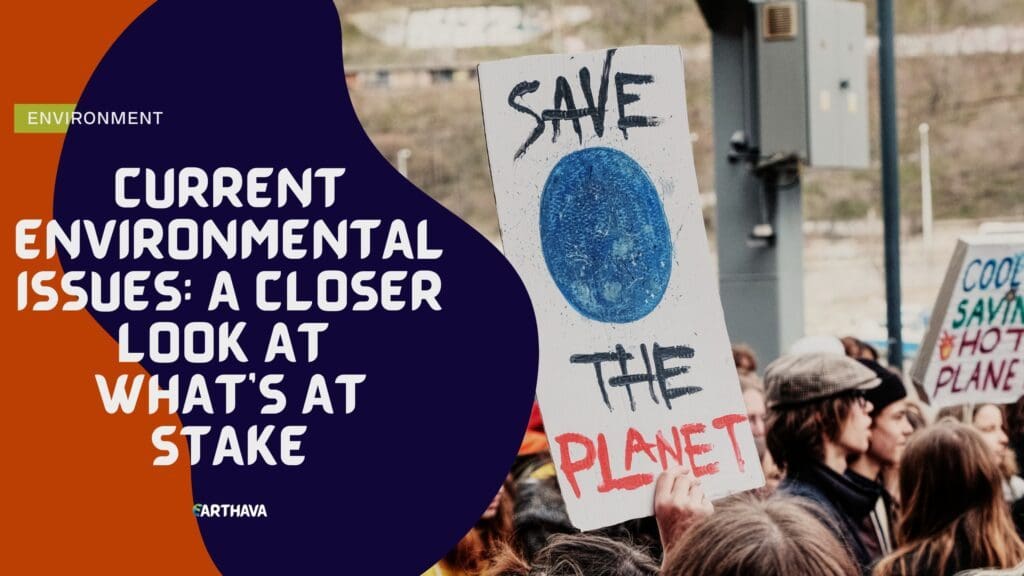Climate change and global warming are in everyone’s mind.
According to the UN, we still have 12 years to limit the climate change problems affecting the planet.

If you haven’t set your New Year’s resolutions, why not start with staying informed about the environment?
In this article, we’ll show you which current environmental issues every one will be talking about.
Ocean’s Water
Water pollution has been an environmental concern for some time and will continue to be. Many pollutants and contaminants threaten our ocean’s water.
Water pollution not only affects marine wildlife, and drinking water but also puts on a financial strain on resources.
Plastic is a real problem that pollutes the oceans of the world. When people buy plastic products, about half of them end up as waste in the oceans. It’s estimated that 8 million tons of plastic end up in the ocean and ecosystem each year.
Deforestation
Plants play a very important role in our lives and our planet. We need plants to survive. Plants not only provide us with shade and shelter, but they also provide us with oxygen, food, medicine, and water. Humans and animals alike depend on trees and plants to survive.
The rapid deforestation of forests and jungles will be something to pay attention to.
Illegal logging is a serious concern since it decreases the forests at an alarming rate. Deforestation contributes to 15% of greenhouse emissions.
Air Pollution
Even though the Clean Air Act has made it possible for cleaner air, this type of pollution continues to be a concern.
Air pollution weakens the ozone layer, threatens wildlife, and causes health problems. Those who live in cities or areas with high levels of air pollution are more likely to develop lung cancer.
Humans can take charge of air pollution and make a change before it’s too late.
Climate Change: Raising Oceans
Unless you’ve been living under a rock, you must have heard people talking about the threat of rising oceans, this will continue to be a concern.
In the 1990s, the sea levels would rise by approximately 1.1 millimeters a year steadily throughout the decade. Currently, the sea level is rising at about 3.1 millimeters each year.
This seems like a small number to many, but it’s important to note the number tripled in only a few decades.
There’s still hope for rising oceans if we only cut down on greenhouse emissions, which can bring down the 57-inch rise to 36 inches.
Water Quality & Supply
As mentioned earlier, the world’s oceans are in danger due to plastic, oil spills, and other pollutants. Drinking water quality and supply have also been taking a hit.
Several regions in the world have been suffering from a shortage of water quality and supply. The decline in the quality of drinking water leads to bottled water consumption. In regions with fewer resources, bottled water might not be a possibility, which can cause dehydration and even illness.
The decline in the water supply also affects the agriculture sector. Excess contaminants deplete the water of nutrients and affect the crops.
Food Production
Environmental issues affect food production all around. The greenhouse emissions and pollution in the air influence the way the crops grow.
Extreme temperature changes lead to changes in the soil and the air, which affects crops.
As we also mentioned earlier, the lack of reliable water supply also affects the agricultural sector.
Although food production will impact areas with low resources, it will affect everyone around. It will increase the cost of food for everyone and in extreme cases lead to famine.
Climate Refugees
Climate refugees is not a term you hear often, but there will be more awareness.
As the sea levels continue to rise, 2 billion people will be displaced from their homes by the year 2100. This is one-fifth of the world’s population who live on the coastlines of the world.
It’s important to create awareness of climate refugees. If more and more societies and governments acknowledge the reality, we can prevent climate refugees.
Biodiversity
Everyone knows the ecosystem works on a cycle of its own. Biodiversity exists in every single region which makes each ecosystem unique.
Environmental issues threaten the world’s biodiversity. If greenhouse emissions, global warming, and deforestation don’t stop, billions of species of animals could be on the verge of extinction.
If you take small steps towards reducing your carbon footprint, you can make a positive impact on biodiversity.
Climate Illnesses
Environmental issues not only increase air pollution-related illnesses. Global warming affects more than the quality of the air.
Extreme climate changes can lead to malnutrition and can even spread diseases such as malaria.
Climate-related illnesses can end up costing a lot of money, approximately $4 billion by 2030.
Fortunately, creating awareness about this issue can help prevent the spread of diseases such as malaria. More and more governments are becoming aware of this issue and taking the necessary steps.
Wildfires
Wildfires have been at an all-time high in the last few years. Extreme climate change is the culprit behind these wildfires. In 2017, the U.S. experienced a record-breaking 58,000 wildfires.
The rise in temperatures is making places like the state of California get hotter. It depletes the soil of moisture, which makes it susceptible to fires.
Climate change can also lead to drought, which is also responsible for wildfires.
Wildfires displace people, and wildlife, and cause severe property losses. It’s important to take precautions to prevent wildfires from being ignited.
Current Environmental Issues: The Bottom Line
Current environmental issues such as wildfires, climate illness, climate refugees, and air pollution will be on everyone’s mind.
It’s important to create awareness regarding these issues so we can all become environmentally conscious.
Want to take steps to help the environment? Check out this article on why plastic waste is in everyone’s mind.


